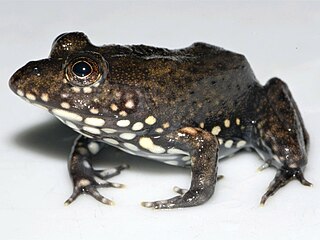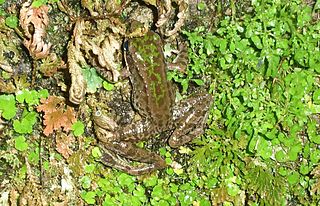
African dwarf frog is the common name for members of Hymenochirus, a genus of aquatic frog native to parts of Equatorial Africa. They are common in the pet trade and are often mistaken for the African clawed frog, a similar-looking frog in the same family. African dwarf frogs. Their common name is obtained from their place of origin and the claws on their hind legs.

Hymenochirus boettgeri, also known as the Zaire dwarf clawed frog or the Congo dwarf clawed frog, is a species of frog in the family Pipidae. It is found in Nigeria, Cameroon, Equatorial Guinea, Gabon, and east to the Central African Republic and to eastern Democratic Republic of the Congo. It presumably occurs in the Republic of the Congo but has not been recorded there. It is a common species over most of its wide range and the International Union for Conservation of Nature has assessed its conservation status as being of least concern.
Arthroleptis schubotzi, also known as the Burundi screeching frog, Schubotz's squeaker, and Kivu dwarf litter frog, is a species of frog in the family Arthroleptidae. It is found in the African Rift Valley in eastern Democratic Republic of the Congo (Kivu), southwestern Tanzania, Burundi, Rwanda, and western Uganda. There are taxonomic problems in delimiting this species.

Scotobleps is a monotypic frog genus in the family Arthroleptidae; its sole species is Scotobleps gabonicus, sometimes known as the Gaboon forest frog or Gabon forest frog. It is found in eastern Nigeria, western and southwestern Cameroon, Equatorial Guinea, western Gabon, western Republic of the Congo, and western Democratic Republic of the Congo. Its range could extend into the Cabinda Enclave of Angola.
Sclerophrys fuliginata is a species of toad in the family Bufonidae. The specific name fuliginata is Latin for "sooty", in reference to the species' appearance of a more or less diffusely uniform exterior color and pattern. It is also known as the Shaba Province toad or sooty toad. It is found in the southern Democratic Republic of the Congo, southeastern Tanzania, and northern Zambia.
Dendropsophus stingi is a species of frogs in the family Hylidae. It is endemic to Colombia and occurs on the eastern slope of the Cordillera Oriental in the Boyacá Department. The species was named after celebrity musician Sting in recognition of his "commitment and efforts to save the rain forest". Despite this, common name Kaplan's Garagoa treefrog has been coined for it.
Hyperolius kuligae is a species of frog in the family Hyperoliidae. It is found in southwestern Cameroon, Gabon, and Equatorial Guinea and eastward to the central Democratic Republic of the Congo; it probably occurs in northern Republic of the Congo and the Central African Republic too. It is also reported from Uganda, but the status of this population is unclear. The specific name kuligae honours Paul Kuliga (1878–1948), a physician who joined an expedition to Cameroon in 1936. Common names Camp Kivu reed frog and Kuliga reed frog have been proposed for it.
Helena's marsupial frog is a species of frog in the family Hemiphractidae. It is endemic to the Páramo de Tamá on the Venezuelan-Colombian border and occurs in Apure and Táchira states of Venezuela and Norte de Santander Department on the Cordillera Oriental of Colombia. It is named after Helen Gaige, an American herpetologist.
Telmatobius ignavus is a species of frog in the family Telmatobiidae. It is endemic to the Cordillera de Huancabamba in the Department of Piura, Peru. Common name Piura water frog has been coined for it.

Phrynobatrachus parvulus is a species of frog in the family Phrynobatrachidae. It is widely distributed in the upland areas of Central and East Africa in Angola, northern Botswana, northern Zimbabwe, Zambia, southeastern Democratic Republic of the Congo, Malawi, and Tanzania. However, many identifications are problematic, and the taxonomic status of this species with respect to Phrynobatrachus mababiensis and P. ukingensis requires clarification; in the more inclusive species delimitation applied by the IUCN SSC Amphibian Specialist Group, also Uganda is tentatively included in the range of this species. Common names Loanda river frog, dwarf puddle frog, and little puddle frog have been proposed for this species.
Phrynobatrachus scapularis is a species of frog in the family Phrynobatrachidae. It is endemic to the northern and northeastern Democratic Republic of the Congo. The specific name scapularis refers to shoulder blades (scapulae). Common name Buta river frog has been coined for it.
Hymenochirus boulengeri, also known as eastern dwarf clawed frog, is a species of frog in the family Pipidae. It is endemic to northeastern Democratic Republic of the Congo where it is only known from two localities. It is presumably ecologically similar to Hymenochirus boettgeri, an aquatic frog that occurs in still, shaded water in lowland rainforest, and in pools by slow-flowing rivers. Threats to this little-known species are unknown.

Amnirana lepus is a species of frog in the family Ranidae. It is found in Cameroon, Equatorial Guinea, Gabon, Central African Republic, Republic of the Congo, Democratic Republic of the Congo, and northern Angola. Common names Andersson's Cameroon frog, Andersson's white-lipped frog, and jumping white-lipped frog have been proposed for it.

Aubria masako is a species of frog in the family Pyxicephalidae. It is found in southeastern Cameroon, eastern Gabon, southwestern Central African Republic, northern Republic of the Congo, and eastward to the central Democratic Republic of the Congo, with one (doubtful) record from Angola; it might occur in Equatorial Guinea. Common names Masako ball frog and Masako fishing frog have been coined for this species. Whether it is distinct from Aubria subsigillata has been debated, but at present it is treated as a valid species.
Ptychadena perreti is a species of frog in the family Ptychadenidae. It is found in Cameroon, Gabon, Republic of the Congo, southwestern Central African Republic and northern Democratic Republic of the Congo. It might occur in the Cabinda enclave of Angola and mainland Equatorial Guinea. Common name Perret's grassland frog has been coined for it.
Ptychadena uzungwensis is a species of frog in the family Ptychadenidae. It is found on the East African Plateau in Rwanda, Burundi, and Tanzania in the north and then southward to eastern Democratic Republic of the Congo, northern Angola, Zambia, Malawi, Zimbabwe and uplands of Mozambique. Its common names include Udzungwa ridged frog and Udzungwa grass frog, where "Udzungwa" may also be written Uzungwa, following the spelling that Arthur Loveridge used in the species description for the Udzungwa Mountains, the type locality.
Ptychadena wadei is a species of frog in the family Ptychadenidae. It is endemic to Ethiopia and only known from a small area southeast of Lake Tana, in the upper reaches of the Blue Nile. The specific name wadei honours Edward O.Z. Wade, an English illustrator and herpetology enthusiast who drew some of the illustrations accompanying the species description. Common name Wade's grass frog has been coined for it.

Odorrana swinhoana is a species of frog in the family Ranidae. It is endemic to Taiwan and widely distributed in hilly areas below 2,000 m (6,600 ft). It is named for Robert Swinhoe, a British naturalist and diplomat. Its common names include Swinhoe's brown frog, Bangkimtsing frog, brown-backed odorous frog, Taiwan odorous frog, and Taiwan sucker frog.

Chiromantis petersii is a species of frog in the family Rhacophoridae. It is found in Kenya and Tanzania and is broadly distributed in the inland areas of both countries. Chiromantis kelleri was previously considered subspecies of Chiromantis petersii, but is currently recognized as a distinct species. These two species are sympatric in northern Kenya.
Rhacophorus exechopygus is a species of frog in the family Rhacophoridae. It is found in the Central Highlands of Vietnam and in the adjacent Annamite Range in Laos. Its range may extend into northeastern Cambodia where suitable habitat should be present. The specific name exechopygus is derived from the Greek words exechos and pygos (=buttocks), referring to the infra-anal projection characteristic of this frog. Its common names are spinybottom tree frog and Tramlap flying tree frog.









